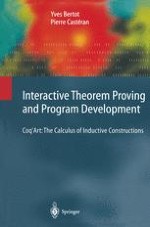2004 | Buch
Interactive Theorem Proving and Program Development
Coq’Art: The Calculus of Inductive Constructions
verfasst von: Dr. Yves Bertot, Dr. Pierre Castéran
Verlag: Springer Berlin Heidelberg
Buchreihe : Texts in Theoretical Computer Science. An EATCS Series
Enthalten in: Professional Book Archive
